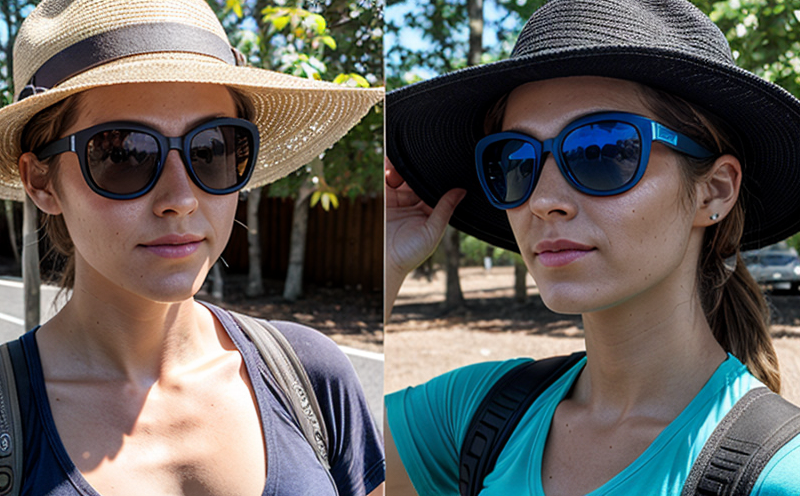Laboratory measurement of light transmittance in thin fabrics
The laboratory measurement of light transmittance in thin fabrics is a critical process used to assess the ability of textiles to block or transmit ultraviolet (UV) radiation and visible light. This test is particularly important for industries that produce clothing, sun protection products, and other items exposed to sunlight. The primary goal is to ensure that materials meet specific standards for UV protection, which are essential for consumer health and safety.
Thin fabrics such as cotton, polyester blends, and specialty textiles often have varying degrees of light transmittance properties due to their fiber composition, weave density, and finishing treatments. These properties can significantly influence the fabric's ability to protect against harmful UV rays while also affecting its appearance and comfort. A precise measurement of light transmittance allows manufacturers to make informed decisions about material selection and processing.
The testing process involves several key steps: sample preparation, instrument calibration, measurement execution, data analysis, and reporting. Samples are typically cut into standard sizes that represent the fabric's intended use in garments or other products. The instruments used for this purpose include spectrophotometers capable of measuring light transmission across different wavelengths.
The results provide valuable insights into how effectively a given textile can shield users from UV radiation. This information is crucial not only during product development but also throughout production and quality control processes where regular testing ensures consistent performance levels among batches of materials.
Understanding the factors that influence light transmittance is essential for achieving optimal protective qualities without compromising comfort or aesthetics. Factors such as fiber type, yarn count, weaving pattern, dyeing methods, and post-treatment finishes all play significant roles in determining these characteristics. By controlling these variables during manufacturing, companies can tailor their products to meet specific market demands regarding UV protection standards.
Standards like ISO 12727:2004 provide guidelines on conducting accurate measurements of light transmittance through textiles. These international standards ensure consistency across laboratories worldwide, enabling better comparison between different materials and facilitating compliance with regulatory requirements set forth by various countries or organizations.
In summary, laboratory measurement of light transmittance in thin fabrics is a vital tool for ensuring the effectiveness of UV protection features within textile products. It helps manufacturers achieve desired performance characteristics while maintaining high-quality standards throughout production cycles.
International acceptance and recognition of this test are crucial for ensuring that textile products meet global standards. Many countries have adopted ISO 12727:2004 as their official standard, which provides clear guidelines on how to conduct accurate measurements of light transmittance through textiles.
The widespread adoption of these standards ensures consistency across different regions and helps manufacturers comply with local regulations more easily. Additionally, international recognition enhances the credibility of test results, making them valuable for both domestic and export markets.
By aligning with global best practices, companies can build trust among consumers who value safety and quality assurance. This alignment also facilitates easier trade negotiations and reduces barriers to entry into new markets.
Use Cases and Application Examples
The laboratory measurement of light transmittance in thin fabrics has numerous applications across various industries, particularly those focused on personal protection against UV radiation. Here are some specific use cases:
- Sunscreen clothing: Manufacturers can optimize fabric designs to maximize UV protection while ensuring comfort and durability.
- Baby products: Ensuring that fabrics used in baby clothes meet strict safety standards regarding light transmittance is essential for protecting young skin from harmful rays.
- Sports apparel: Athletes often require lightweight, breathable garments with excellent UV protection capabilities. Testing helps ensure these properties are achieved without sacrificing performance.
- Outdoor gear: From tents to backpacks, all outdoor equipment needs effective UV barriers to extend product life and provide user safety.
In addition to consumer goods, industrial applications include protective clothing for workers exposed to sunlight during their jobs. These industries rely heavily on accurate light transmittance measurements to meet regulatory requirements and protect employees from potential hazards.
Why Choose This Test
- To ensure compliance with international safety regulations and industry standards
- To improve product quality by identifying potential issues early in the development stage
- To enhance customer satisfaction through superior performance attributes
- To provide objective data supporting claims made on product labels
- To facilitate continuous improvement based on real-world testing results
- To support research and development efforts aimed at creating innovative solutions
- To maintain competitive advantage by staying ahead of evolving market trends
- To reduce risks associated with non-conforming materials entering the supply chain





